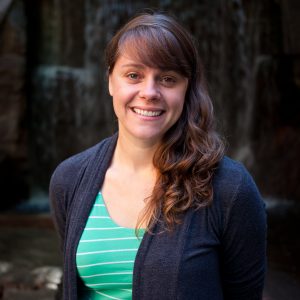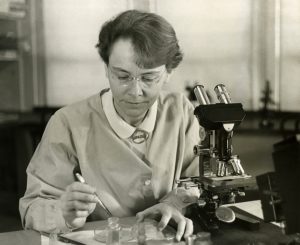An Especially Inspiring Nobel Prize, and a Sign of More Work to Do

Dr. Jennifer E. Adair, PhD, associate professor, Clinical Research Division and Cell and Gene Therapy Program, Fred Hutchinson Cancer Research Center, and research associate professor, University of Washington.
A historic moment for women in science
Early in the morning of Wednesday, Oct. 7, we heard news that buffered the impact of the chaos and tragedy of this year.
For the first time in history, women almost matched men for Nobel Prize awards across all categories.
One in particular stood out.
Two women shared the award in Chemistry: Dr. Jennifer Doudna of the University of California at Berkeley and Dr. Emmanuelle Charpentier of the Max Planck Institute for the Science of Pathogens in Berlin, Germany for their co-development of a method of genome editing.
Just writing that sentence brings tears to my eyes.
There are a couple reasons why. The 2012 discovery by Doudna and Charpentier, that CRISPR systems derived from bacteria and phages can be repurposed to re-write the DNA of nearly any organism, opened the door for a new era in biology. That discovery has helped fuel my own research in human gene therapy as an early-career faculty member at the Fred Hutchinson Cancer Research Center.
However, the reason that gets me running for the tissue box is that they didn’t have to share this award with a man.

Barbara McClintock in the lab, 1947.
To be clear, this hasn’t happened for a Nobel Prize in Chemistry since 1964. That year, Dr. Dorothy Crowfoot Hodgkin became only the second solo female laureate in history for her application of X-ray crystallography to solve protein structures. She was preceded by the only other solo female laureate, Dr. Marie Skłodowska Curie in 1911 for her discovery of the elements radium and polonium.
The Nobel Prize in Medicine has once gone unshared to a woman, Dr. Barbara McClintock in 1983 for her discovery of mobile genetic elements. No female laureate of the Nobel Prize in Physics has ever been honored alone, in fact all four female laureates in Physics have shared their prizes with two male laureates.
One very, very small step towards equity
Between 1901 and 2020, a total of 931 Nobel laureates have been named. Only 58 (6.2%) are women. Women comprise only 15.9% of Literature laureates, 13.7% of Peace laureates, 5.4% of Medicine laureates, 2.4% of the Memorial Prize in Economic Sciences laureates and 1.9% of Physics laureates.
With this year’s announcement, the prize in Chemistry now boasts an impressive 1 percentage point increase in female laureates from 2.7% in 2019, to 3.8% in 2020 (seven women out of a total 186 Chemistry laureates).
That may not sound like much progress, but there is a long-term trend at work. About half of all the female Nobel laureates — 28 out of the 58 in history — were honored between 2001 and 2020. That sounds like significant progress, but it should be considered against the total number of laureates in the same 20-year time period. There were 232 total laureates counting men, women, and organizations, which means that women have only won 12.1 percent of the prizes in the 21st century. Only 12 of these laureates (5.2%) were awarded for Chemistry, Physics or Medicine.
To put this in perspective, women make up about 42 percent of PhD degree recipients in Science, Technology, Engineering or Mathematics (STEM) fields.
The root of the problem
When Presidential candidate Joe Biden announced he would select a woman as his Vice Presidential running mate in 2020, responses were mixed, even among women. I heard echoes of the age-old argument, “Shouldn’t the best candidate win?”
The problem with this argument is that the meritocracy isn’t based on a level playing field – it is biased towards men.
Of all the evidence I could cite here, consider just a few recent findings. A 2019 study in JAMA showed that women in science receive less research funding than their male colleagues, even when grant scores are similar. Another 2020 study by researchers at Northeastern University found that women are biased against in peer-reviewed journals.
Two other studies objectively illustrate just how deep gender bias in science goes. The first was a randomized, double-blind study published in PNAS in 2012.
In this study, science faculty in chemistry, biology and physics were asked to review resumes for a lab manager position. Resumes were identical and were randomly assigned male- or female-associated names. Male-named applicants were consistently ranked higher than female-named applicants, despite identical merit on paper.
This bias was explored further in a more recent study published in Sex Roles last year. In this study, resumes were again randomly assigned names, but this time both gender and race were examined. The position for consideration was postdoctoral fellow. This study supported the known gender bias especially evident in Physics, and further underscored the intersectionality of race and gender as the most biased against across all sciences – again, in the context of equal merit on paper.
It is sad and unsurprising then that of the 22 Hispanic Nobel Prize recipients, only two are women and neither of whom are included in the six Hispanic laureates honored in Chemistry or Medicine. Only six Nobel laureates are known to have identified as LGBTQ. Exactly zero of the Nobel laureates in Chemistry, Physics or Medicine are Black.
How (white) men can and need to help
The Swedish Academy of Sciences committee intended to grant the 1911 Nobel Prize in Chemistry to both Marie and her husband Dr. Pierre Curie, but Pierre died in an accident in 1906 and the award stipulations prevent posthumous award recipients, granting the historic award to Marie alone. With her default-solo Nobel in Chemistry in 1911 following her husband’s death, Dr. Curie also became the only woman in history to win a Nobel Prize twice. She shared her first Nobel Prize in Physics in 1903 with her husband and her doctoral advisor, Dr. Henri Becquerel. Initially only Pierre and Henri were nominated, but after learning of their nomination they decided to lobby the Nobel Prize committee for Marie to be included.
Dr. Hodgkin’s Nobel Prize nomination was solo from the outset, as she had solved both the crystal structures of penicillin in 1945 and Vitamin B12 in 1955. But her nomination didn’t come until two years after colleague Dr. Max Perutz shared the Nobel Prize in Chemistry with Dr. John Kendrew for solving the protein structure of hemoglobin, in 1959.
Indeed, Perutz has been quoted as saying, “I felt embarrassed when I was awarded the Nobel Prize before Dorothy, whose great discoveries had been made with such fantastic skill and chemical insight and had preceded my own.”
Dr. McClintock received her solo 1983 Noble Prize in Medicine more than 33 years after her discovery of mobile genetic elements. In her autobiography, she gives credit to Dr. C.B. Hutchison for inviting her to take his graduate level genetics course at Cornell University, Dr. Lester W. Sharp for his cytology course, and Dr. Rollins A. Emerson, who paired McClintock with fellow graduate students Marcus M. Rhoades and George W. Beadle, who became a Nobel laureate in 1958.
In these cases, and in all of the shared Nobel Prizes awarded to women, men had to open the door. Not only the men named above, but also the nominators, who must meet a set of stringent criteria which greatly favors men, and the prize committees, which have been made up entirely or predominantly of men throughout history. Today, less than 25% of Nobel Prize committee members are female.
When only one group has a majority seat at the table and owns the building the table sits in, they have the ultimate power to invite anyone else in to sit down. They have to actively push for others who do not look like or relate to them to join, and they need to do this by deconstructing their own perceptions of meritocracy.
Drs. Doudna and Charpentier didn’t just have to exceed peer-reviewed publishing standards and funding norms, they had to commercially advance their methodology and simultaneously become global advocates for ethical application of the technology. The result of this momentous effort is a tool that continues to rewrite not just DNA, but nearly all of the life sciences.
Since nomination and committee determinations for Nobel Prizes are made over the course of a year and sealed for a period of 50 years after the award is made, it will be a very long time before we have insight into the decisions behind this year’s awards. Regardless, it is a long overdue positive message to young female scientists like myself, and scientist-hopefuls everywhere.
There are many, many more exceptional candidates working incredibly hard, making groundbreaking discoveries, and waiting and hoping for their chance to someday get the call from Stockholm. Everyone must realize that to the newcomers, the rooms and tables and decorum are unfamiliar and will likely need to change.
True equity and inclusion requires many, many new steps and challenges beyond opening the door, pulling out the chair and sitting down. In short, everyone needs to get uncomfortable for at least some time. The sooner we start seeing and listening to one another at the same tables, the shorter the discomfort will be for everyone.
Even more important, beyond that discomfort lies an infinite number of new ideas whose benefits to the planet and humanity are exponentially diverse.
Dr. Jennifer E. Adair, PhD is an Associate Professor in the Clinical Research Division and Cell and Gene Therapy Program at the Fred Hutchinson Cancer Research Center, and a Research Associate Professor at the University of Washington, both in Seattle. Despite an unexpected pregnancy at 19, and another at 20, Jen completed her Bachelor of Science degree in Chemistry at Youngstown State University while on welfare in 2000.
She then went on to complete her doctoral degree in Genetics and Cell Biology at Washington State University in the laboratory of Dr. Raymond Reeves in 2005, during which she gave birth to her third child. After 2 years as a post-doctoral fellow in the laboratory of Dr. Kenneth Olden, the first African American Director of a National Institute of Health, Jen returned to the Pacific Northwest to start her career in gene therapy at Fred Hutch under Dr. Hans-Peter Kiem.
She started her independent laboratory in 2014 to develop tools and methods for delivering gene therapy to patients who need it, anywhere in the world. That same year she adopted her fourth child. In addition to science and science writing, Jen is an inventor, girls soccer coach and volunteer with Boys & Girls Clubs of America, including an interactive program to introduce children to gene therapy science. She is an advocate for the ethical application of gene therapy and diversity in science. Her research has been honored by TEDx, Geekwire and AAAS to name a few. In 2020, Jen was named the Fleischauer Family Endowed Chair in Gene Therapy Translation. You can learn more about Jen here.



